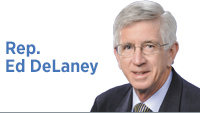Subscriber Benefit
As a subscriber you can listen to articles at work, in the car, or while you work out. Subscribe Now The Legislature under the guidance of the supermajority has double-faulted in the game of education finance. Since obtaining control in 2011, the Republican caucuses have managed to cut the college-going rate from 66% to 53%. In the same period, they have forced homeowners, and other property-tax payers, to increase their property-tax support of our traditional public schools 50%. That’s right. Property-tax support per student has risen from about $2,600 per student per year to nearly $4,000. Nice work.
The Legislature under the guidance of the supermajority has double-faulted in the game of education finance. Since obtaining control in 2011, the Republican caucuses have managed to cut the college-going rate from 66% to 53%. In the same period, they have forced homeowners, and other property-tax payers, to increase their property-tax support of our traditional public schools 50%. That’s right. Property-tax support per student has risen from about $2,600 per student per year to nearly $4,000. Nice work.
Meanwhile, tuition-support funding for charters and vouchers has risen from $6 million per year to a bit more than $750 million. But let us not assume that more is being spent on education in total. In 2011, 44.3% of our state budget went to K-12 education (nearly all to traditional public schools). That percentage has dropped to 39.8% for FY 2024. Of course, the drop for traditional public schools has fallen more: from 43.1% of our budget in FY 2011 to 36.4% in FY 2024.
The 2025 session of the General Assembly provides an opportunity to carry out our constitutional duty to fund public schools and to relieve some of the pressure on property taxes. For some 20 years, we have failed in our obligation to fund “a general and uniform system of common schools,” which are required to be tuition-free and open to all. (Art. 8 of the Indiana Constitution). Driven by ideology, and by aversion toward public schools, the other party has volunteered to fund schools that are not uniform in any way and schools that charge tuition. This assumption of what had been someone else’s duty has led to the diversion of state funds from the schools attended by some 90% of our children. At the same time, this diversion of state funds has forced an increased reliance on locally raised property taxes to fund the schools that are open to all and regulated by our voters.
If the legislative majority had not embarked on this experiment, it could fully fund public schools while reducing pressure on homeowners. It is not clear that the diversion of hundreds of millions of dollars a year also required a reduction in support to public schools from state income and sales taxes. That was what seems to be a matter of choice, not necessity. The supermajority has other preferences, like paying cash when interest rates were low or bragging about a large state surplus.
While the proponents of “choice” in education loudly proclaim that we are spending more in total on education, the facts noted above don’t bear this out. We simply devalue education in toto, while posturing about the increases in funding for the favored voucher and charter formats. Increases for these formats are a genie that will never be put back in the bottle. It is as if parents have picked two favored kids to shower with gifts while cutting back on the rest of their brood for a net “saving.”
Even the supermajority recognizes that an educated populace is the key to attracting businesses to Indiana and staffing the ones already here. Their logic is clear, but their math is bad. They leave empty seats in colleges and community colleges that we invested in. And if the percentage of the approximately 80,000 kids entering school each year drops, as it has, we stand to lose some 10,000 college-goers a year. This is choice? This is reform?•
__________
DeLaney, an Indianapolis attorney, is a Democrat representing the 86th District in the Indiana House of Representatives. Send comments to ibjedit@ibj.com.
Click here for more Forefront columns.
Please enable JavaScript to view this content.
